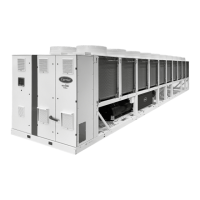4 - WATER CONNECTIONS
WARNING: Before carrying out any water connections, install
the water box bleed plugs (one plug in the lower section of
each water box -supplied in the electrical cabinet).
When connecting units to the water distribution pipe work, refer
to the certied dimensional drawings supplied with the unit for the
dimensions and position of the exchanger water inlet and outlet
connections.
The piping must not transmit any axial or radial force to the
exchangers, or any vibrations.
The water must be analysed. Depending on the results, the circuit
created must include the elements needed for water treatment:
lters, additives, intermediate exchangers, bleed devices, vents,
isolation valves, etc., to prevent corrosion, fouling, and deterioration
of the pump ttings.
Carrier recommendations on heat exchange uids:
1. No NH
4+
ammonium ions in the water, as these cause
signicant damage to copper. This is one of the most
important factors governing the service life of copper
piping. A content of several tenths of mg/l will badly
corrode the copper over time.
2. Cl
-
chloride ions also cause damage to copper with a risk
of perforating corrosion. If possible keep below 125 mg/l.
3. SO
4
2-
sulphate ions can cause perforating corrosion if
their content is above 30 mg/l.
4. No uoride ions (<0.1 mg/l).
5. No Fe
2+
and Fe
3+
ions if non negligible levels of dissolved
oxygen are present. Dissolved iron < 5 mg/l with dissolved
oxygen < 5 mg/l.
6. Dissolved silicon: Silicon is an acid element of water and
can also lead to a risk of corrosion. Content < 1 mg/l.
7. Water hardness: >0.5 mmol/l. Values between 1 and 2.5
mmol/l can be recommended. This will facilitate scale
deposit that can limit corrosion of copper. Values that are
too high can cause piping blockage over time. A total
alkalimetric titre (TAC) below 100 mg/l is desirable.
8. Dissolved oxygen: Any sudden change in water
oxygenation conditions must be avoided. It is as
detrimental to deoxygenate the water by mixing it with
inert gas as it is to over-oxygenate it by mixing it with pure
oxygen. The disturbance of the oxygenation conditions
encourages destabilisation of copper hydroxides and
shedding of particles.
9. Electric conductivity 10-600µS/cm
10. pH: Ideal case pH neutral at 20-25°C (7.5 < pH < 9).
If the hydraulic circuit is drained for a period of more than one
month, blanket the entire circuit with nitrogen to prevent any risk
of corrosion by dierential aeration.
WARNING: Filling, topping up, or emptying of the water circuit
mustbecarriedoutbyqualiedpersonnelusingtheairbleed
devices and tools and equipment suitable for the products.
The heat-transfer medium should be lled and drained using
devices tted to the water circuit by the installer. Never use the
unit heat exchangers to add heat exchange uid.
4.1 - Operating precautions
Before commissioning, make sure the hydraulic circuits are
connected to the appropriate heat exchangers.
The water circuit should be designed to have the least number of
elbows and horizontal pipe runs at dierent levels. Below the main
points to be checked for the connection:
■ Ensure the inlet water and outlet pipes are connected in the
direction shown on the unit.
■ Install manual or automatic vents at all high points in the
circuit(s). The latter must be installed outside of buildings (ATEX
zone 2 possible at the air vent discharge).
■ Maintain the pressure of the circuit(s) with pressure-reducing
valves and install a relief valve and an expansion vessel.
■ Units equipped with the hydraulic module include a relief valve.
Units with option 293 include an expansion vessel.
■ Install thermometers in both the water inlet and outlet pipes.
■ Install drain connections at all low points to allow the whole
circuit(s) to be drained.
■ Install shut-off valves close to the water inlet and outlet
connections.
■ Use flexible connections to reduce the transmission of
vibrations.
■ Insulate the cold water pipework, after pressure testing, to
prevent heat transmission and condensation.
■ Cover the insulation with a vapour barrier.
■ The brine loop must be clean. To ensure the exchangers are
able to operate correctly, it is recommended that a sludge
container, settling container, or another ltration system is also
installed upstream of the unit, if necessary.
■ If there are particles: In the uid which are liable to foul the
exchanger, a screen lter must be installed upstream of the
pump. It must be located somewhere easily accessible to
enable disassembly and cleaning. The mesh size of this lter
must be 1.2 mm (see Typical hydraulic installation diagram).
■ Do not introduce any excessive static or dynamic pressure into
the heat exchange circuit (with regard to the design operating
pressures).
■ Before any start-up, verify that the heat-transfer medium is
compatible with the materials and the water circuit coatings.
■ The use of dierent metals in the hydraulic system may create
galvanic couples and lead to corrosion. Verify the need to install
sacricial anodes.
■ If additives or uids other than those recommended by Carrier
are used, ensure that these are not considered gases, and that
they are class 2, as dened in directive 2014/68/EU.
■ For a hydraulic module (opt. 116A & 116W), when lling with
heat-transfer medium, remember to vent the air contained in
the pump body (see g. below). Otherwise, there is a risk that
the pump will deteriorate prematurely.
23

